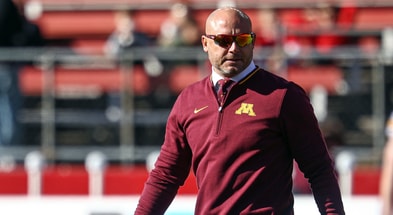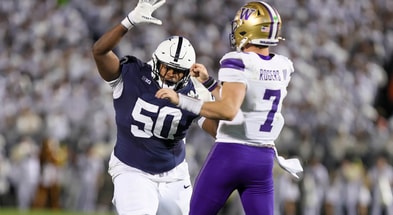James Franklin addresses Penn State NIL progress made, ongoing concerns

Penn State head coach James Franklin met with reporters Tuesday evening for the final time before Saturday’s Blue-White Game. Immediately following the program’s spring practice session, Franklin took questions about progress made over the past month, staffing standouts, and position flexibility on the offensive line.
None of his answers were as compelling as a five-minute discussion regarding Penn State’s standing in name, image, and likeness.
On the front end, Franklin tackled the topic and the role it plays in a competitive program in today’s college football. On the back end, he addressed where Penn State is in its trajectory toward truly competing in the space.
Both answers lent an up-to-the-minute insight tracing the earliest days of Penn State’s NIL strategy and approach to where the program is today.
Assessing Penn State NIL status
Given his history of being outspoken about the necessity of having a “bold and aggressive” stance on NIL for the program, that somewhat naturally demanded an acknowledgment of past mistakes that were made.
“We still got a ton of work to do. We started in the first couple years where we said we were going to teach student-athletes how to be entrepreneurs,” Franklin said. “That was our NIL model. So we were two years behind everybody else.
“I think over the last year, we’ve made significant progress. But, if you give somebody a two-year start in basically a three-year model, I think it’s pretty obvious.”
Laying the framework essential to his vision of competition and the attitude necessary to realize it, Franklin said that the current public discussion regarding the school’s NIL approach shouldn’t be necessary.
James Franklin laments past mistakes
Rather, at a program that prides itself on its accomplishments and position in the broader college football landscape, the elements demanded of that place cannot be ignored.
“When you’re Penn State, and you’re in the Big Ten, the reality is, if you choose and want to compete at the very highest level, you can’t pick and choose what you’re going to compete in,” Franklin said. “Whether it’s facilities, whether it’s staff size, whether it’s alignment, whether it’s NIL, whether it’s all these things; if you truly want to compete at the highest level, then you can’t say we’re going to be competitive in these three areas and not in this one.
“Where we are as a top 10 program, those areas that you are behind become glaring, obvious issues to people that understand and study college football and college athletics.”
Top 10
- 1Breaking
Biff Poggi
Charlotte firing head coach
- 2Hot
Skipping SEC title game
Coaches prefer sitting out
- 3
Predicting new CFP Top 12
BCS formula predicts 12-team bracket
- 4New
Kiffin calls out Saban
'He's now the rat poisoner'
- 5
Dabo rips refs
Swinney headed to 'Targeting Anonymous'
Pointing to the progress made in facilities for Penn State, having recently completed a $48 million expansion to the Lasch Building, Franklin added that the narrative regarding resources has been distorted over the years.
From Holuba Hall’s place as one of the early indoor facilities in the game to the introduction of the Lasch Building, which had been at the forefront of football-specific buildings, Franklin rejected the notion that Penn State hasn’t tried or needed to compete away from the playing field.
“It’s interesting when some of the storylines had been, ‘Well, we didn’t have these things in the past.’ Well, we really did,” Franklin said. “That football facility was the best facility in all the football, college teams from all over the country, NFL teams came to visit it. So I don’t know where that storyline came from, but it’s not accurate.”
Next steps
Determined to do his part in the NIL space to position the program as best as he can to compete, Franklin said that has demanded a comprehensive approach to understanding what is being done elsewhere in the game.
Calling his understanding “a pretty good pulse” of what’s happening nationally through his conversations with athletic directors, other coaches, and even newcomers to the staff coming from outside the program, Franklin said the work has continued to educate the donor class and fan base what’s needed in NIL to properly compete.
Proud of progress made thus far, though, Franklin alluded to the recent departure of basketball coach Micah Shrewsberry to Notre Dame as evidence of Penn State’s work still needed.
“We’ve made significant ground up in the last year,” Franklin said. “But again, we got to keep the pedal to the floor. We just saw some decisions that weren’t completely made, in the basketball program, but that was a big part of it. We know that.”
























